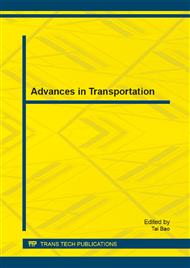p.1102
p.1107
p.1114
p.1118
p.1122
p.1127
p.1133
p.1137
p.1143
Evaluation of Signal Control Strategy Based on Hardware-in-the-Loop
Abstract:
To evaluate the performance of different signal control strategies in intersection, based on the Hardware-In-The-Loop (HITL) simulation technology, a HITL system was established to perform experiment. In the system, microscopic traffic simulation software VISSIM created a virtual environment, in which the traffic flow can be controlled by the real signal controller. One type of intersection and four degrees of traffic volume were designed in the simulation program and three control strategies were set in the signal controller. Twelve simulations were performed in the system. The analysis of travel time and queuing length indicates that different strategies has remarkable influence on travel time, but no significant effect on queuing length.
Info:
Periodical:
Pages:
1122-1126
Citation:
Online since:
January 2014
Authors:
Price:
Сopyright:
© 2014 Trans Tech Publications Ltd. All Rights Reserved
Share:
Citation:


